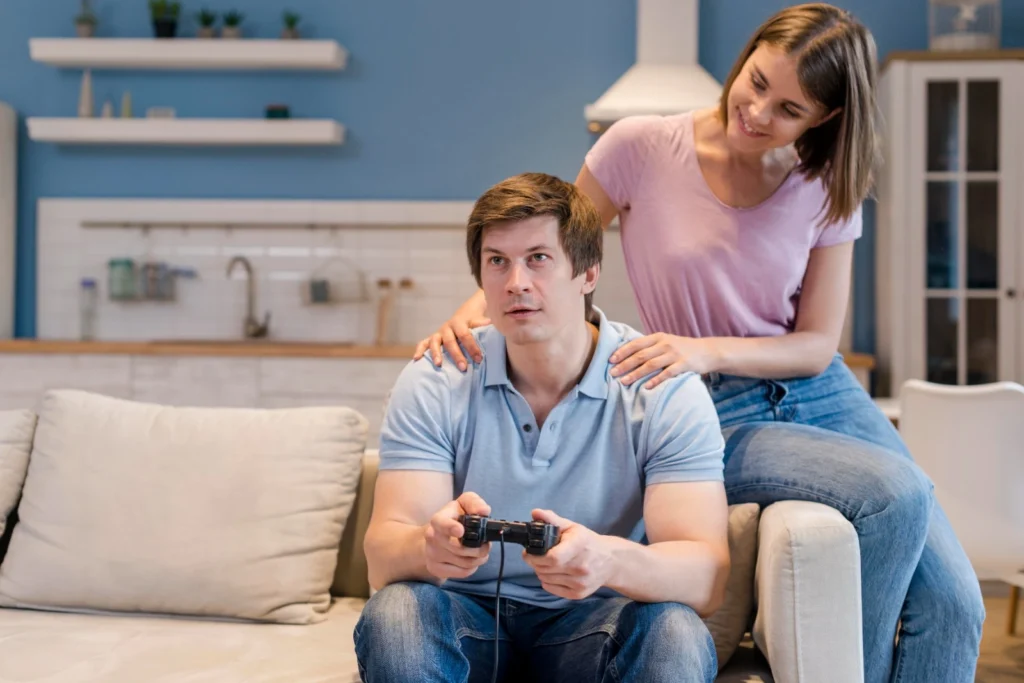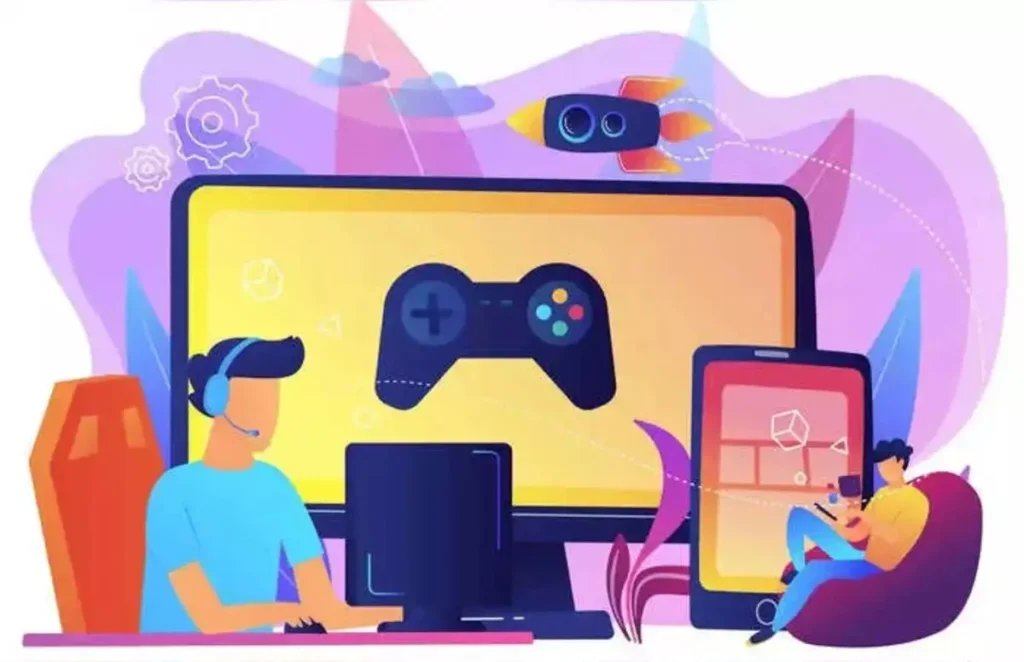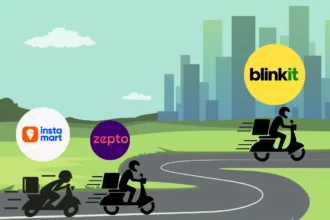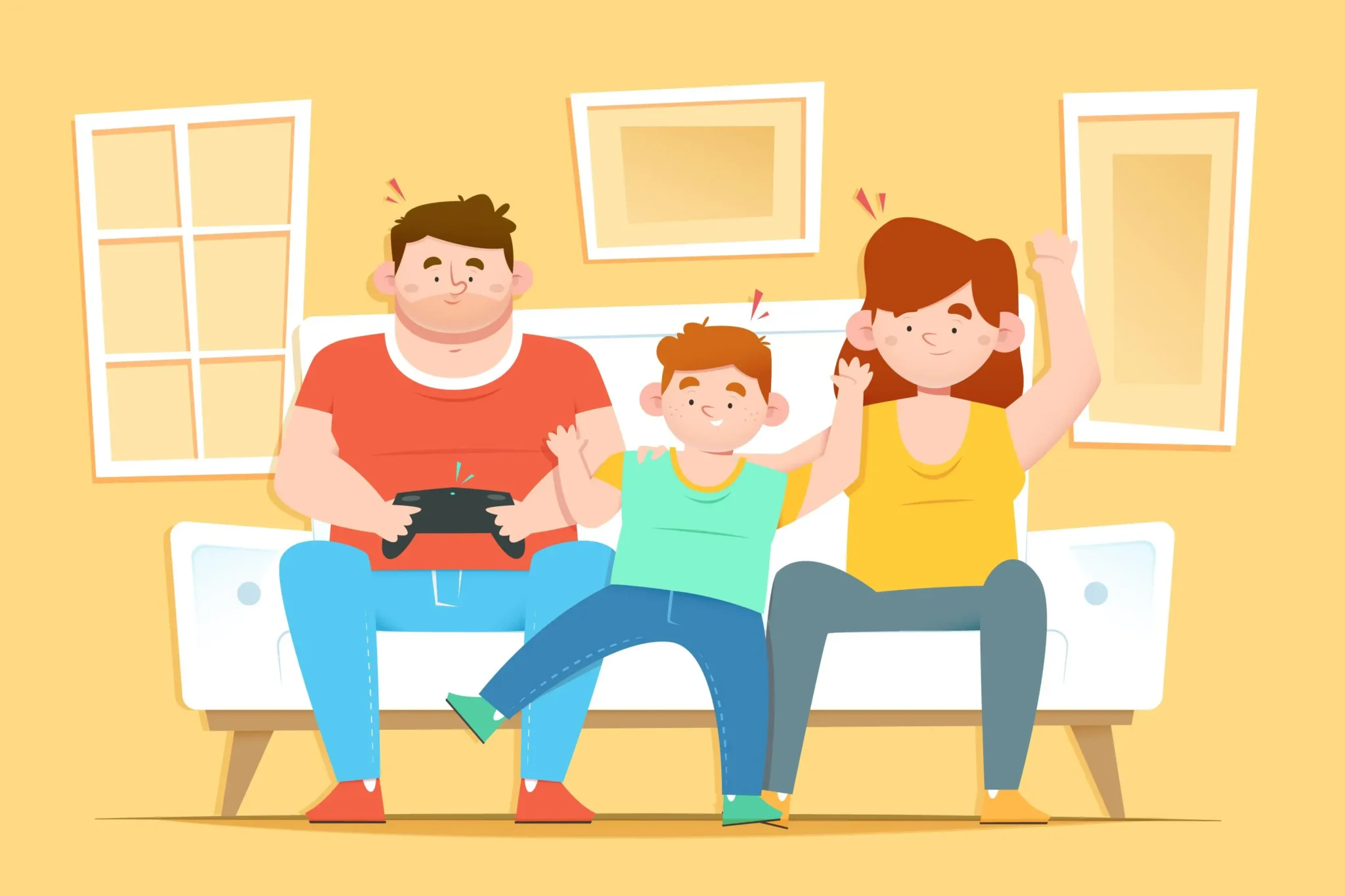Estimated Reading Time: 26-30 minutes (5,210 words)
Introduction
Video games are everywhere today — in teenagers’ pockets, on their consoles, and woven deeply into their social lives. What began as a hobby has evolved into a mainstream cultural force, with teens spending hours daily on titles like BGMI, Fortnite, Roblox, Valorant, and FIFA. For many, gaming provides excitement, skill-building, and a sense of community that extends far beyond the screen. But this growing reliance also raises an important question: What is constant gaming doing to young minds?
Over the past decade, researchers across the world — from the WHO, APA, NIMHANS, and leading universities — have been digging into the psychological effects of gaming on adolescents. Their findings are nuanced: gaming can improve cognitive flexibility, problem-solving, and social connection, yet it can also trigger anxiety, aggressive behavior, sleep disruption, and addiction-like symptoms when used excessively. In India especially, where cheap smartphones and 4G/5G access have fueled a massive gaming boom, the mental-health conversation has become unavoidable. Cases of gaming disorder reported at AIIMS and NIMHANS have increased, and many families are struggling to set boundaries without fully understanding the underlying science.
This article breaks down the reality — far beyond fear-driven headlines or oversimplified opinions. We’ll explore how gaming can both help and harm teenagers, the psychological pathways involved, early warning signs parents should watch for, and evidence-based strategies to build healthier gaming habits. Whether you’re a parent worried about screen time, a teacher observing behavior changes, or a teen wanting to understand your own habits, this guide will give you the clarity, data, and actionable insights you need.

What Is Internet Gaming Disorder (IGD)?
Internet Gaming Disorder (IGD) is a behavioural addiction in which a person’s gaming activity becomes so excessive and compulsive that it begins to disrupt daily life, mental health, academic performance, and relationships. Unlike casual or even frequent gaming, IGD involves loss of control over playtime and an inability to stop despite clear negative consequences. The condition has gained global recognition:
- The World Health Organization (WHO) officially included “Gaming Disorder” in its ICD-11 classification (2019).
- The American Psychiatric Association (APA) listed IGD as a condition requiring further study in the DSM-5, underscoring its growing clinical importance.
IGD is not about blaming games or labelling every gamer as “addicted.” Instead, it focuses on patterns of behaviour where gaming becomes the dominant activity in someone’s life—often replacing sleep, studies, family interaction, and even basic self-care.
Diagnostic Criteria (Explained in Detail)
Clinicians typically look for persistent and recurrent gaming behavior lasting 12 months or more, accompanied by at least five of the following symptoms:
- Preoccupation with gaming: Constantly thinking about the next game session, strategies, or outcomes, even during school or social activities.
- Withdrawal symptoms: Anxiety, irritability, restlessness, or sadness when unable to play.
- Tolerance: Needing to spend increasing amounts of time gaming to feel satisfied or reach the same excitement level.
- Loss of control: Inability to cut back or stop gaming despite trying repeatedly.
- Loss of interest in other activities: Previously enjoyed hobbies, sports, or social interactions gradually fade away.
- Continued gaming despite problems: Persisting even when grades drop, family conflicts worsen, or health issues arise.
- Deception: Lying to parents, teachers, or friends about how much time is spent gaming.
- Escape: Using gaming to avoid real-life problems, stress, or negative emotions.
- Jeopardizing opportunities: Missing school deadlines, skipping classes, neglecting responsibilities, or damaging relationships due to gaming.
Why Teens Are More Vulnerable
Teenagers’ brains are still developing—especially the prefrontal cortex, responsible for impulse control and decision-making. Combined with:
- instant rewards in games
- social pressure from peers
- competitive game mechanics
- leaderboards and daily “streaks” …teens are biologically and socially more susceptible to developing IGD than adults.
Prevalence of Gaming Disorder Among Adolescents
Understanding how widespread Internet Gaming Disorder (IGD) is among teenagers is essential for policymakers, parents, and educators. Over the past decade, researchers have conducted large-scale studies across continents to map the extent of problematic gaming. The findings reveal that IGD is not a fringe issue — it is increasingly recognized as a public-health concern, with certain regions and demographic groups showing significantly higher vulnerability.
Global Studies: What Worldwide Research Shows
Across international literature, IGD prevalence varies widely depending on assessment tools, cultural context, and gaming habits. However, a consistent trend emerges: male teenagers in Asia show the highest risk.
- Global prevalence ~3.05%:
A 2024 prospective cohort study protocol published by BioMed Central estimates the worldwide IGD prevalence at 3.05%, with rates often higher in East and Southeast Asia due to intense academic pressures, smartphone penetration, and a booming competitive gaming culture. - Asian trends show early onset + social drivers:
Research across Korea, Japan, and China indicates that early exposure to mobile gaming, long sessions in multiplayer titles, and peer influence drive up the risk of problematic play. Boys are more likely than girls to show symptoms of IGD, often linked to preference for competitive or combat-based games. - China: One of the largest adolescent samples (n = 7,900+):
A major study reported significant links between IGD and
- poor emotion regulation
- harsh or inconsistent parenting
- low family cohesion
- higher screen exposure
These psychosocial factors create a cycle where teens use gaming to cope with emotional stress, further exacerbating addictive patterns.
- poor emotion regulation
- Co-occurring mental-health conditions:
Global data consistently shows IGD correlates with:
- depression
- social anxiety
- poor sleep hygiene
- loneliness
- ADHD symptoms This reinforces that IGD is not just a habit problem — it connects deeply with psychological well-being.
- depression
India-Specific Data: How Common Is IGD Among Indian Teenagers?
India has witnessed one of the fastest-growing gaming populations in the world, driven by affordable smartphones and cheap data. As a result, local researchers have increasingly studied the mental-health impact among school-age children and teens.
Here’s what Indian evidence reveals:
1. Assam (Sonitpur District) – Prevalence: 0.6%
A cross-sectional study found:
- 0.6% of school students met criteria for IGD.
- Key risk factors included:
- prolonged gaming hours (often late at night),
- lack of parental monitoring,
- low academic engagement.
- prolonged gaming hours (often late at night),
This lower prevalence may reflect rural/urban divides in gaming access.
2. Ahmedabad (Gujarat) – High Prevalence: 15.8% (Grades 9–12)
A study involving 2,200 high-school students using the IGDS9-SF scale found:
- 15.8% showed scores indicating IGD risk — significantly higher than national averages.
- IGD scores were strongly associated with:
- academic stress
- insomnia
- late-night gaming
- school absenteeism
- academic stress
This highlights the mental-health impact of “always-on” multiplayer games in urban areas.
3. High School Population Study – 17.1% Prevalence
Another large-scale study reported:
- 17.1% prevalence among Indian adolescents.
- IGD strongly correlated with
- depression
- anxiety
- chronic stress
- impaired sleep quality
- depression
These figures suggest that in certain urban pockets, nearly 1 in 5 teens may show signs of problematic gaming.
4. Younger Children (8–12) in Salem, Tamil Nadu – Prevalence: 1.2%
Studies among younger students found more modest rates:
- 1.2% prevalence in children aged 8–12.
- IGD showed a significant correlation with:
- anxiety
- depressive symptoms
- difficulty regulating emotions
- anxiety
This suggests that problematic gaming can emerge even in preteens, though the severity tends to increase with age.
5. Smartphone Addiction + IGD Link (India-wide Study, n = 845)
A study examining smartphone dependence in adolescents found:
- a moderate positive correlation between smartphone addiction and IGD
- high-risk predictors included:
- male gender
- rural residence
- easy access to gaming devices
- certain education levels (higher risk in classes 9–12)
- male gender
This supports the growing view that IGD is part of a broader pattern of digital dependence.
Overall Interpretation: What the Data Means
- IGD prevalence in India ranges from 0.6% to 17%, depending on region, age group, and methodology.
- Urban teens with easy access to high-performance smartphones, competitive online games, and social gaming environments are particularly vulnerable.
- Across all studies, emotional health, sleep quality, and academic stress consistently correlate with problematic gaming.
How Gaming Can Negatively Influence Teen Mental Health
While gaming can offer cognitive and social benefits, the risks emerge when play becomes excessive, compulsive, or emotionally driven. For many teenagers, gaming is not just a hobby — it becomes a coping mechanism for stress, loneliness, or academic pressure. This shift can set the stage for serious mental health challenges. Current research from India and worldwide shows clear associations between problematic gaming and issues like depression, anxiety, sleep disturbance, impulsivity, and addictive tendencies.
Depression, Anxiety & Psychological Stress
A growing number of studies are uncovering strong links between IGD and emotional health problems in teenagers:
- IGD & Emotional Distress:
Research published in the Industrial Psychiatry Journal found that 17.1% of adolescents who met the criteria for gaming disorder also displayed significantly higher levels of depression, anxiety, and psychological stress. This is particularly concerning because early emotional dysregulation often worsens gaming dependency, creating a self-reinforcing cycle. - Younger Children Affected Too:
Studies in Tamil Nadu involving children aged 8–12 years found that problematic gaming correlated with measurable levels of anxiety and depressive symptoms. This suggests emotional vulnerability doesn’t start in the teenage years — it can begin in primary school when gaming becomes a primary outlet for dopamine-driven reward seeking. - Broader Emotional & Behavioral Issues:
Reports from Psychreg and other mental-health organizations highlight that excessive gaming in Indian youth is associated with:
- irritability
- mood swings
- social withdrawal
- reduced interest in hobbies
- difficulty dealing with frustration
- irritability
These emotional patterns often mimic early symptoms of depression or anxiety disorders.
Sleep Deprivation & Declining Academic Performance
Sleep is one of the first casualties when gaming becomes excessive — especially among teens who prefer late-night multiplayer sessions.
- COVID-19 Period Study (Southern Karnataka):
A study conducted during the pandemic found that 7% of youth met criteria for IGD. Those with higher gaming hours also showed:
- impaired academic performance
- increased impulsivity
- difficulties with peer interaction
- lower concentration in online classes
- impaired academic performance
- Sleep Quality Impairments:
Multiple studies published in LWW Journals indicate a strong association between gaming disorder and:
- delayed sleep onset (“just one more match”)
- poorer sleep efficiency
- daytime sleepiness
- difficulty waking up for school
- delayed sleep onset (“just one more match”)
Poor sleep then worsens mood, memory, decision-making, and academic outcomes — amplifying mental health risks.
Impulsivity, Stress, and Impulse Control Problems
One of the most consistent findings in adolescent IGD research is heightened impulsivity — both as a cause and a result of problematic gaming.
- Impulsivity in Indian Male Gamers:
A comparative study published in the Indian Journal of Psychological Science (IJIP) found that males diagnosed with IGD were significantly:
- more impulsive
- more stress-prone
- more likely to show emotional reactivity
- more impulsive
This combination increases the likelihood of using gaming as an escape mechanism.
- Smartphone Addiction Link:
The same research found that impulsive smartphone usage — especially rapid task-switching across apps — predicted IGD.
Teens who constantly check notifications, hop between apps, and chase instant stimulation display traits similar to:
- behavioral addiction
- poor impulse control
- dopamine-seeking loops
- behavioral addiction
This helps explain why mobile-first countries like India see fast-growing IGD rates.
Dark Patterns, Manipulation & Monetization-Driven Harm
Modern games are no longer simple entertainment tools — they’re built on advanced psychological design frameworks meant to maximize engagement.
Recent studies (e.g., arXiv) highlight several dark patterns:
1. Variable Reward Systems
Games often use unpredictable rewards — similar to slot machines — which boost dopamine spikes and keep players hooked.
2. Social Pressure Mechanics
Features like:
- leaderboards
- guild obligations
- daily login streaks
…pressure teens to return daily or risk “letting the team down.”

3. Time-Limited Events & FOMO
Flash events, seasonal skins, and limited-time bonuses manipulate players into staying online longer.
4. “Gacha” Mechanics (Loot Box Systems)
Extremely popular in mobile games (Genshin Impact, Free Fire, FIFA Mobile), gacha-style systems mimic gambling:
- randomized rewards
- “near misses”
- high emotional stakes
Research shows these systems may:
- increase gambling-like tendencies
- worsen financial impulsivity
- create psychological dependence
For teenagers — who have developing brains and lower impulse control — these mechanics can be especially harmful.
Summary of Risks
Problematic gaming in teenagers is linked to:
- higher rates of depression, anxiety, and emotional dysregulation
- worsened sleep and declining academic performance
- increased impulsivity and smartphone dependence
- exposure to manipulative game design and gambling-like mechanics
The combination of biological vulnerability (developing brain), social drivers, and psychologically engineered games makes adolescents particularly susceptible.
The Positive Side: How Gaming Can Support Teen Well-Being
Social Connection & Identity
For many teenagers, gaming has evolved far beyond a hobby — it’s a central social ecosystem. Multiplayer titles like Valorant, Fortnite, Roblox, and Minecraft function as virtual hangout spaces where teens collaborate, compete, or simply spend time together. These environments can foster a strong sense of belonging, especially for teens who may feel isolated offline. Through guilds, clans, or team-based activities, players learn cooperation, communication, and conflict resolution.
Games also offer a platform for identity exploration: avatars, in-game roles, and customizable characters allow teens to experiment with self-expression in a low-risk environment. Research shows that for socially anxious or neurodivergent adolescents, online gaming communities can provide a comfortable entry point to socialize without the pressures of face-to-face interaction.
Additionally, studies highlight that not all gaming is detrimental — in fact, moderate and community-oriented gaming can strengthen peer relationships. Cooperative gameplay in particular has been linked to increased empathy, teamwork, and prosocial behavior.
Cognitive Benefits & Resilience
Beyond social gains, gaming offers measurable cognitive advantages. Action and strategy games often require rapid decision-making, pattern recognition, multitasking, and resource management — skills that can translate into improved attention, faster reaction times, and enhanced executive functioning. Certain genres, like puzzle or simulation games, can improve planning, spatial reasoning, and long-term strategic thinking.
Gaming can also play a role in emotional resilience. Research indicates that structured, moderate gameplay may help adolescents decompress after school, process mild stressors, or take a cognitive break from academic pressure. For some teens, games act as a “safe space” where they can practice perseverance, cope with failure, and build self-efficacy — especially in games that reward incremental improvement or teamwork.
When balanced appropriately, gaming can complement healthy development by offering challenge, mastery, creativity, and meaningful social engagement.
Risk Factors That Make Some Teens Vulnerable
Understanding why certain adolescents develop problematic gaming behaviors while others don’t is crucial. Internet Gaming Disorder (IGD) doesn’t emerge in isolation — it’s shaped by psychological, environmental, and design-related factors. Research across India and global populations reveals several high-risk patterns:
Smartphone Addiction & Digital Overuse
A 2024 Indian study reported a moderate positive correlation between smartphone addiction and IGD, showing that teens who compulsively check their devices, overuse social apps, or rely on phones for emotional regulation are more likely to slide into excessive gaming. Because most Indian teens primarily game on smartphones, this overlap intensifies risk: constant access, push notifications, and low-friction game design create a cycle of impulsive use, reward seeking, and longer play sessions.
Gender, Geography & Socioeconomic Factors
Across multiple studies, boys consistently show higher rates of IGD, likely due to greater exposure to competitive, immersive, and reward-heavy games. Meanwhile, rural adolescents — an emerging focus in Indian mental health research — may face added vulnerabilities such as limited recreational alternatives, heightened academic/peer competition, or lower parental digital literacy. Lower socioeconomic households may also lack awareness of online risks or have fewer boundaries around screen use, further increasing susceptibility.
Duration & Intensity of Play
One of the strongest predictors of IGD is sheer time spent gaming. Research repeatedly links longer daily or weekly hours to higher risk, especially when sessions exceed 3–4 hours or involve late-night play. Marathon gaming, binge sessions during holidays, or “always online” competitive games can disrupt sleep patterns, reduce academic focus, and create a dependence on gaming for stimulation or emotional escape. The pattern matters as much as the duration: teens who skip meals, ignore responsibilities, or lose track of time while playing are significantly more vulnerable.
Lack of Parental Monitoring or Digital Supervision
Low parental oversight — whether due to time constraints, unfamiliarity with games, or permissive attitudes toward screen time — is one of the most consistently identified risk factors. Teens whose parents do not understand game mechanics, competitive ranking systems, or monetization strategies are more likely to engage in unhealthy patterns. Without boundaries around device use, gaming hours can escalate quickly, and children may hide playtime, spend money impulsively, or use games to avoid stress without adults noticing early warning signs.
Game Design Risks: Manipulative Mechanics & Monetization
Certain game designs amplify vulnerability, especially for teens already prone to impulsivity, anxiety, or reward-seeking behavior. Loot boxes, gacha systems, endless progression loops, time-limited events, and variable-ratio reward schedules operate similarly to gambling mechanisms — unpredictable rewards create compulsion and repeated engagement. Fast-paced games with artificial “wins,” daily login bonuses, or social pressure to stay competitive can trap teens in cycles of craving, frustration, and overuse. Vulnerable adolescents, particularly those with poor emotional regulation, are disproportionately affected by these mechanics.
Real-World Case Studies & Research
- Ahmedabad Study (2023–24): 2,200 high school students; 15.8% showed IGD-like behavior; linked with insomnia and stress. PubMed
- Sonitpur, Assam: Among 538 students, IGD prevalence was 0.6%. High weekday/weekend gaming predicted risk; parental monitoring was protective. PMC
- Smartphone-IGD Study (2024): Among 845 Indian adolescents, IGD risk was higher for males, rural youth, and those with smartphone addiction. IJIP
- Psychosocial Impacts: Industrial Psychiatry Journal found that adolescents with gaming disorder (17.1%) also had higher rates of depression, anxiety, poor sleep, and stress. LWW Journals
Prevention Strategies & Healthy Gaming Habits
Preventing problematic gaming isn’t about banning games — it’s about building awareness, structure, and healthier digital habits. Effective prevention requires coordinated action from parents, educators, and teens themselves. Below are detailed, evidence-informed strategies that help keep gaming enjoyable while minimizing mental health risks.
For Parents
Set Clear, Consistent Boundaries
Establish rules about daily gaming duration, weekend exceptions, and “no-gaming zones” (e.g., the dining table, study time, or right before bed). Use built-in parental controls on consoles, smartphones, or routers to automate limits. Consistency is key — irregular rules can cause conflict or lead to hidden play.
Encourage a Balanced Lifestyle
Support offline hobbies like sports, music, art, reading, and outdoor activities. Teens who have diverse interests are less likely to rely on gaming as their only source of enjoyment or stress relief. Family activities and shared routines can also reduce excessive screen time without confrontation.
Educate Teens About Game Design & Manipulation
Explain why certain games feel addictive. Talk about loot boxes, gacha systems, daily quests, “limited-time events,” and how game companies use reward psychology (like variable-ratio reinforcement) to keep players hooked. When teens understand the mechanics, they’re more likely to self-regulate.
Open Monitoring & Healthy Conversation
Instead of surveillance, use curiosity. Ask questions like:
– “Who do you usually play with?”
– “What do you like about this game?”
– “Are there parts of the game that make you stressed, or feel pressured?”
This builds trust and makes teens more likely to discuss problems early.
Protect Sleep & Daily Routine
Sleep loss is one of the strongest pathways linking gaming to mental health issues. Enforce:
– no gaming 1–2 hours before bed
– no late-night multiplayer sessions
– devices kept outside the bedroom at night
Healthy sleep improves mood, focus, and emotional regulation.
For Educators / Schools
Introduce Digital Well-Being Education
Schools can integrate modules on gaming addiction, screen-time management, cyberpsychology, and online behavior. Lessons on self-regulation, emotional triggers, and balanced digital use can equip students with tools they don’t learn at home.
Early Screening & Support Systems
Teachers and counselors can use brief screening tools (such as the IGD-9 Scale or digital habits questionnaires) to identify students showing warning signs: declining grades, absenteeism, excessive fatigue, or social withdrawal. Early intervention can prevent escalation to clinically significant IGD.
Workshops & Parent Orientation Sessions
Parents often misunderstand modern games, especially competitive titles with ranking systems or monetization. Schools can run workshops to teach parents:
– how IGD develops
– healthy screen routines
– what types of games are riskier
– how to communicate positively with teens
This builds a unified home-school approach.
For Teens
Build Self-Awareness About Your Gaming Patterns
Ask yourself: “Am I playing to relax, to escape stress, to compete, or because I feel bored?”
Understanding your motivation helps you gain control instead of letting the game control you.
Practice Mindful, Intentional Gaming
Set personal rules:
– specific gaming hours
– alarms or timers to end sessions
– no gaming during school breaks or late nights
You can even treat gaming like a reward after finishing school tasks.
Use Structured Break Techniques
Adopt methods like Pomodoro: 45 minutes of gameplay followed by a 10–15 minute break. Breaks allow your brain to reset, reduce impulsivity, and prevent emotional over-immersion in high-intensity games.
Reach Out When Gaming Starts Interfering
If gaming affects sleep, grades, mood, or friendships — it’s not a failure to ask for help. Speaking to a counselor, teacher, parent, or even a peer mentor can help catch issues early. Modern IGD treatment focuses on counseling, routine-building, and emotional regulation — not punishment or banning games.
When to Seek Help: Screening & Intervention
Recognizing when gaming has crossed from a hobby into a mental health concern is crucial. Many teens (and parents) overlook early symptoms, assuming gaming is “just a phase” — but timely intervention can prevent long-term emotional, academic, and behavioral problems. Below is a detailed breakdown to help identify red flags, understand screening options, and know where to seek support.
Warning Signs to Watch For
Problematic gaming usually develops gradually. Look for clusters of symptoms, not just one behavior.
Behavioral Indicators
- Preoccupation/obsession: Constantly thinking or talking about gaming, even when not playing.
- Loss of control: Inability to reduce playtime despite wanting to.
- Escalation of gaming: Increasing hours spent on games to feel the same satisfaction (“tolerance”).
Emotional Red Flags
- Irritability, anger, or restlessness when gaming is interrupted or restricted.
- Mood swings linked to gaming outcomes (e.g., feeling depressed after losing).
- Using gaming as an escape from stress, loneliness, anxiety, or conflict.
Functional Impairment
- Declining academic performance: incomplete homework, dropping grades, absences.
- Sleep disturbances: staying up late, daytime fatigue, difficulty waking up.
- Reduced social interaction: withdrawing from friends, avoiding family time.
- Physical symptoms: headaches, eye strain, neck pain, irregular meals.
When multiple symptoms persist for 3 months or more, it may signal Internet Gaming Disorder (IGD) or emerging digital addiction.
Screening Tools for Early Assessment
If you suspect problematic gaming, simple screening methods can provide clarity:
IGDS9-SF (Internet Gaming Disorder Scale – Short Form)
A widely validated 9-item tool based on DSM-5 criteria. It assesses preoccupation, withdrawal, tolerance, conflict, and functional impairment. Scores can help determine whether a teen is at risk, problematic, or in the clinical range.
GASA (Gaming Addiction Scale for Adolescents)
Evaluates gaming behaviors across dimensions like salience, mood modification, conflict, and relapse.
Digital Habit Strength Index or Screen Time Logs
Tracking screen time, game sessions, and triggers for play can help identify patterns and severity.
While self-assessments can offer early insights, a clinical evaluation is necessary for a formal diagnosis.
Where to Seek Professional Help
Help can come from multiple sources depending on severity:
School-Based Resources
- School counselors trained in adolescent behavior and digital well-being.
- Teachers who observe academic or behavioral declines and can flag concerns early.
Mental Health Professionals
- Psychologists or child psychiatrists experienced in behavioral addictions.
- Clinical psychologists who can administer validated assessments and therapy.
Specialized Digital Addiction Clinics
In India, a growing number of hospitals and mental health centers have launched “digital well-being” or “technology addiction” clinics, where professionals address gaming disorder alongside smartphone and social media addiction. (Reported by The Times of India.)
Online or Community Programs
- Digital detox programs
- Youth counseling centers
- Helplines offering mental health support
Evidence-Based Intervention Models
Treatment for problematic gaming focuses on improving self-regulation, emotional awareness, and family communication — not banning or shaming.
Cognitive Behavioral Therapy (CBT) for IGD
Helps teens identify triggers, challenge gaming-related beliefs, and replace compulsive gaming with healthier coping strategies.
Motivational Interviewing (MI)
Useful for teens who deny the problem or lack motivation to change. It helps build internal motivation and commitment toward healthier habits.
Parent–Teen Therapy / Family Intervention
Addresses family conflict, communication patterns, boundary-setting, and co-created gaming rules.
Structured Time-Management & Behavior Plans
Includes schedule-building, reward systems, habit stacking, and accountability plans to reduce excessive gaming gradually.
Comorbidity Treatment
If gaming is linked to depression, anxiety, ADHD, or stress, these conditions are treated alongside IGD for better outcomes.
FAQs Section
1. What is the difference between “normal gaming” and Gaming Disorder?
Normal gaming is recreational, intentional, and balanced with school, sleep, friendships, and family responsibilities. Teens play for fun, relaxation, or social interaction, but they can stop when needed. There is no major impairment in daily life.
Gaming Disorder (IGD), as recognized in WHO’s ICD-11, involves:
- Loss of control over gaming (can’t reduce playtime despite wanting to)
- Prioritizing gaming over other life activities
- Continuing to play despite harm, such as worsening grades or conflicts
- Functional impairment, including emotional distress, sleep loss, or withdrawal from family
If these symptoms persist for 12 months or more, clinicians may diagnose IGD. For teens, impairment in school performance or social life is often the first noticeable sign.
2. How common is Internet Gaming Disorder in teenagers?
Global prevalence:
- Around 3.05% according to a 2024 prospective cohort protocol (BioMed Central).
- Higher rates are consistently reported in East and Southeast Asia.
India-specific prevalence varies widely by region:
- 15.8% among high-schoolers in Ahmedabad (n=2,200; IGDS9-SF) — a significant number also had insomnia and high stress.
- 17.1% in another Indian adolescent study linking IGD with depression, anxiety, and sleep impairment (LWW Journals).
- 0.6% in Sonitpur, Assam — lower, but still correlated with poor parental oversight.
- 1.2% among children aged 8–12 in Salem, showing IGD can begin early.
Differences in measurement tools and cultural factors explain the variation.
3. Are boys more likely to have IGD than girls?
Yes. Multiple Indian and international studies confirm that:
- Male adolescents have significantly higher IGD prevalence.
- Boys tend to engage in competitive, reward-heavy, or action games (FPS, battle royale), which have stronger addictive mechanics.
- Girls are more likely to play casual or social games, which typically have lower IGD risk.
One Indian study (IJIP) showed gender was a major predictor of both smartphone addiction and IGD.
4. Can gaming actually improve mental health?
Absolutely — when practiced in moderation. Benefits include:
- Social connection: Multiplayer games can help teens build friendships, especially introverted or socially anxious teens.
- Cognitive benefits: Faster reaction times, improved attention, spatial reasoning, and problem-solving.
- Emotional regulation: Gaming can serve as a stress-relief tool after school.
- Mastery and resilience: Games with level progression teach perseverance, strategy, and delayed gratification.
The key is dose and structure. Benefits disappear when gaming becomes excessive or compulsive.
5. What kinds of games are most risky for developing IGD?
Games with dark patterns or high psychological engagement loops, including:
- Loot boxes
- Gacha mechanics (common in anime-style mobile games)
- Variable reward schedules (unpredictable rewards)
- Competitive ranking systems (Valorant, BGMI, Fortnite)
- Pay-to-win mechanics
- Endless quests with no natural stopping point
A growing body of research (arXiv) equates gacha mechanics with gambling-like behaviors in adolescents.
6. How does smartphone addiction interact with gaming disorder?
A 2024 study (IJIP) found a moderate positive correlation between smartphone addiction and IGD. Why?
- Smartphones provide 24/7 access to games.
- Mobile games often use manipulative reward cycles.
- Teens can play in short bursts — making it easy to escalate usage.
- Notifications and social pressure (guild events, team invites) create constant triggers.
Smartphone overuse increases impulsivity, which in turn amplifies gaming compulsion.
7. Can parents actually do anything to reduce IGD risk?
Yes, and their involvement is often the most protective factor. Parents can:
- Set clear screen-time boundaries (e.g., max 2 hours/day on school nights).
- Use parental controls or family accounts on consoles and smartphones.
- Encourage offline hobbies like sports, music, reading, or coding.
- Have open conversations about gaming motivations (“Why do you like this game?”).
- Educate teens on dark patterns used in games.
- Establish device-free zones (e.g., dining room, bedroom).
- Create a consistent sleep routine and enforce no-screen periods before bed.
Studies show low parental monitoring is one of the strongest risk factors for IGD in India.
8. Is there treatment for gaming disorder?
Yes. Evidence-based interventions include:
- Cognitive Behavioral Therapy (CBT) for behavioral addictions
- Motivational Interviewing (MI) for resistance or denial
- Family therapy to set boundaries and improve communication
- School counseling + academic support
- Digital detox programs with structured time management
India now has multiple Digital Well-being Clinics, particularly in major hospitals, addressing gaming, smartphone, and social media addiction (reported by The Times of India).
9. Can IGD lead to serious mental health issues?
Multiple studies link IGD with:
- Depression
- Anxiety
- Stress overload
- Sleep disturbances
- Lower emotional resilience
- Irritability and anger outbursts
One Indian study (LWW Journals) found that teens with IGD had significantly worse scores in all major psychological domains. Chronic gaming also contributes to loneliness, reduced physical activity, and poor academic performance.
10. Are some teens more vulnerable than others?
Yes — several studies (IJIP, PMC, LWW) identify high-risk profiles:
- High smartphone users
- Male adolescents
- Teens in rural areas with limited recreational options
- High impulsivity or ADHD-like traits
- Emotion regulation difficulties
- Low parental supervision
- High stress environments (school pressure, family conflict)
Gaming often becomes an escape mechanism for teens already struggling emotionally.
11. How do I know when gaming is “too much”?
You may be crossing into unhealthy territory if:
- You lose sleep because of gaming or stay up until 2–3 AM.
- Your grades drop or you avoid homework to play.
- You skip meals or delay eating to continue gaming.
- You feel irritated, sad, or restless when not playing.
- Friends or family complain that you’re “always gaming.”
- Gaming causes conflict or you lie about how much you play.
A simple test:
If gaming is interfering with school, sleep, social life, or emotional health → it’s too much.
12. Can IGD be prevented?
Yes — through:
- Balanced routines
- Parental involvement
- Early identification
- Self-awareness training for teens
- School-based digital wellness programs
- Healthy sleep and screen habits
The earlier the intervention, the better the outcomes.
Summary / Key Takeaways
- Gaming is not inherently bad — it has both risks and benefits.
- A minority of teens (~1–17% depending on the region and study) show signs of disordered gaming.
- Risk factors: excessive play, impulsivity, smartphone addiction, manipulative game design, lack of supervision.
- Protective practices: parental controls, open communication, balanced offline activities.
- Early intervention helps: screening and professional help can mitigate harm.

Conclusion
Gaming is now woven into the fabric of teenage life — a cultural, social, and emotional space where millions of adolescents worldwide spend their free time. It offers excitement, creativity, connection, and even cognitive growth, shaping identity and peer relationships in ways that didn’t exist a decade ago. When used intentionally and in moderation, gaming can be a meaningful extension of a teen’s social world, a healthy outlet for stress, and a platform to build problem-solving skills and self-confidence. The key is recognizing that gaming itself is not inherently harmful; it’s the context, patterns, and motivations behind use that determine whether the experience becomes enriching or risky.
However, the same medium that fosters community can also create vulnerabilities when boundaries blur. Evidence from global and Indian research shows clear associations between excessive gaming, emotional dysregulation, sleep disturbances, academic difficulties, and symptoms of depression or anxiety. Modern game design — especially mobile titles with dark patterns, unpredictable reward loops, and aggressive monetization — can intensify compulsion in teens who are already struggling with stress, impulsivity, or poor digital habits. These risks underscore the need for informed supervision, open dialogue, and proactive digital wellness education rather than fear-based restriction or stigma.
Ultimately, supporting healthy gaming is a shared responsibility. Parents, educators, and teens themselves must work together through data-driven awareness, compassionate communication, and practical strategies to cultivate a balanced relationship with technology. By setting thoughtful boundaries, encouraging diverse interests, and using early-warning signs to intervene when needed, it’s entirely possible to retain the joy, creativity, and connection that gaming offers — while minimizing the mental health risks. The goal isn’t to eliminate gaming but to shape a digital environment where teens can thrive both online and offline.
References & Sources
- Prevalence of internet gaming disorder in India — IJCMPh study IJCMPH
- IGD, anxiety & depression among children in Salem, Tamil Nadu LWW Journals
- Smartphone addiction and IGD correlation — International Journal of Indian Psychology IJIP
- IGD and mental health in adolescents — Industrial Psychiatry Journal LWW Journals
- IGD during COVID-19 in Karnataka, India PMC
- IGD in Sonitpur, Assam — prevalence & predictors PMC
- High school IGD in Ahmedabad, India PubMed
- Impulsivity, stress & IGD in Indian adolescent males IJIP
- Dark patterns in mobile game design (ethical concerns) arXiv
- Gacha mechanics & gambling-like severity arXiv
- Cohort protocol for studying IGD mechanisms via AI monitoring BioMed Central







